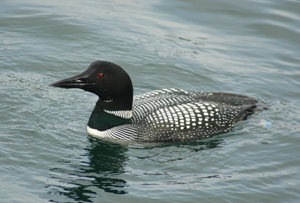Common loons primarily eat fish, but they also eat other small animals. When they nest on lakes that do not have fish, adult loons often feed their young with insects and other invertebrates, but fly to other lakes to find fish to eat themselves.
Photo Credit: Geoffrey A. Hammerson
Gavia immer
Common Name: common loon
Other Common Names: great northern diver
Animal Guild: Bird
Class > Order > Family: Aves > Gaviiformes > Gaviidae
What does the species look like?
Common loons are large-bodied, elongate birds with a heavy bill. Breeding adults have a black head and bill and white checkering on the back. Juveniles and winter adults are rather plain gray on the upper side and white below, with an irregular edge where the gray and white meet on the side of the neck. The wingspan is around 46 inches (117 cm).
Where is the species found?
States & Provinces
AB, AK, AL, AR, AZ, BC, CA, CO, CT, DE, FL, GA, ID, KS, KY, LA, MA, MB, MD, ME, MI, MN, MO, MS, MT, NB, NC, ND, NE, NH, NJ, NL, NM, NS, NT, NU, NV, NY, OH, OK, ON, OR, PA, PE, QC, RI, SC, SD, SK, TN, TX, UT, VA, VT, WA, WI, WV, WY, YT
Distribution
Nesting occurs in Iceland, Greenland, and across Canada and the northern United States to Alaska, and south to California, Montana, the Great Lakes region, New York, New England, and Nova Scotia. In winter, this loon occurs mainly along the Pacific coast from the Aleutians to Baja California and Sonora, along the Atlantic and Gulf coasts from Newfoundland to Florida and west to Texas, and in the western Palearctic along the Atlantic coast to northwestern Africa.
Breeding habitat includes clear lakes containing both shallow and deep water areas. Common loons nest on small islands or mainland shores. They typically raise their young in shallow coves. In winter and during migration, they can be found on inland lakes and rivers, and marine and estuarine coastal waters.
General Phenology and Life History
Northward migration occurs mainly in April and May. The southward return begins late August and early September in the interior of the country, and continues until freeze-up. Migrants arrive in the far north (northern Alaska) in late May or early June. In the southern part of the nesting range, they may arrive as early as March. They lay eggs one to several weeks after arriving at their breeding grounds in the spring, usually during mid-May in the south, and well into June farther north. If the first clutch fails, they may lay new eggs (a replacement clutch) as late as early July. They incubate eggs for around four weeks. Chicks leave the nest within 24 hours of hatching and are soon moved to nursery areas. Adults may carry chicks on their backs until the chicks reach three weeks of age. Most juveniles are capable of flight at 11 to 12 weeks, and some leave the lakes where they were born shortly afterward.
Which phenophases should I observe?
Do you see/hear...?
Activity
Live individuals More...
For abundance, enter the number of individual animals observed in this phenophase.
Feeding For abundance, enter the number of individual animals observed in this phenophase.
Calls or song For abundance, enter the number of individual animals observed in this phenophase.
Territorial individuals For abundance, enter the number of individual animals observed in this phenophase.
Reproduction
Courtship For abundance, enter the number of individual animals observed in this phenophase.
Mating For abundance, enter the number of individual animals observed in this phenophase.
Nest building For abundance, enter the number of individual animals observed in this phenophase.
Occupied nest For abundance, enter the number of individual animals observed in this phenophase.
Development
Downy young For abundance, enter the number of individual animals observed in this phenophase.
Partially-fledged young For abundance, enter the number of individual animals observed in this phenophase.
Fledged young For abundance, enter the number of individual animals observed in this phenophase.
Dead individuals For abundance, enter the number of individual animals observed in this phenophase.
Dead nestlings or fledglings For abundance, enter the number of individual animals observed in this phenophase.
Method
Individuals at a feeding station For abundance, enter the number of individual animals observed in this phenophase.
What do these phenophases look like?
There is currently no photoguide available for this species. If you'd like help us create one, use the guidance document and species template provided here . Then send it via email to education@usanpn.org when it is complete.
